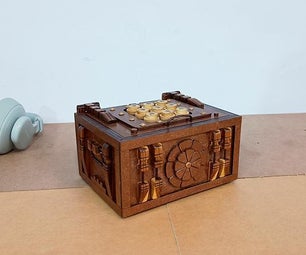Introduction: Lorem Ipsum Christmas Card
The ultimate non-committal greeting card?
Finding the right words can be hard at the holidays. Eventually you start to tire of wishing people "Merry Christmas" or "Season's Greetings". After a while, even "May you survive Krampusnacht with your limbs intact" loses its gloss. So why not fall back on a classic piece of placeholder text to help you really communicate your message?
In just under an hour* of painstaking cutting, gluing and folding you'll be able to give your loved one an elegant pop-up card completely free of any meaningful text. Because it's not what you write on a card that matters; it's the thought that really counts**.
*Estimated time is for handcrafting a single card. Laser cut cards will take much less time.
**Unless you have a laser. Then it's the laser that really counts.
Finding the right words can be hard at the holidays. Eventually you start to tire of wishing people "Merry Christmas" or "Season's Greetings". After a while, even "May you survive Krampusnacht with your limbs intact" loses its gloss. So why not fall back on a classic piece of placeholder text to help you really communicate your message?
In just under an hour* of painstaking cutting, gluing and folding you'll be able to give your loved one an elegant pop-up card completely free of any meaningful text. Because it's not what you write on a card that matters; it's the thought that really counts**.
*Estimated time is for handcrafting a single card. Laser cut cards will take much less time.
**Unless you have a laser. Then it's the laser that really counts.
Step 1: Things You Will Need
Get your kit together! You'll need:
- Two A4 (or letter) sized sheets of card, ideally in contrasting colours. These should be thin and flexible enough to still work in a printer.
- A printer.
- A precise craft knife.
- A cutting board.
- A hard straight edge to cut along (e.g. metal ruler).
- Strong paper glue.
- Good short-distance eyesight or nerves of steel.
Step 2: Print Out Your Plan
One of your two pieces of card will form the pop-up section and the other will be the backing piece. You're only going to be cutting fiddly bits into the pop-up section, so put the backing piece aside for now.
Before you do any cutting, you'll need a plan. To keep the front of your card pristine, print this cutting plan onto the back of your pop-up section. You'll notice that the text is mirrored so that it will read normally from the front.
The plan is designed to fit onto a single landscape-oriented sheet of A4. The image should be about 20 cm in height when printed.
I've included a few different versions of the cutting plan:
Before you do any cutting, you'll need a plan. To keep the front of your card pristine, print this cutting plan onto the back of your pop-up section. You'll notice that the text is mirrored so that it will read normally from the front.
The plan is designed to fit onto a single landscape-oriented sheet of A4. The image should be about 20 cm in height when printed.
I've included a few different versions of the cutting plan:
- JPG file in colour,
- JPG file in black and white,
- PDF file in black and white,
- EPS file for people wielding lasers.
Step 3: Brandish Your Scalpel
Before you do anything else, wash your hands. Yes, you. Trust me, your hands are filthy.You don't want to get smudges all over your card. Wash them now.
Find a well lit, clean, flat work surface and start cutting, following the lines of the plan. Some lines need to be cut all the way through (usually the solid black or grey lines - it will say on the plan) and others should be gently scored to produce straight folding edges. Be careful not to cut where you're not supposed to cut!
Tip: There's a large rectangle around the outside of the fiddly bits. Cut this rectangle out last, or even wait and cut it after you've completed the folding steps.
Find a well lit, clean, flat work surface and start cutting, following the lines of the plan. Some lines need to be cut all the way through (usually the solid black or grey lines - it will say on the plan) and others should be gently scored to produce straight folding edges. Be careful not to cut where you're not supposed to cut!
Tip: There's a large rectangle around the outside of the fiddly bits. Cut this rectangle out last, or even wait and cut it after you've completed the folding steps.
Step 4: Fold. Very... Very... Carefully...
Once you've cut or scored along all of the lines, you can start folding the card. Begin by gently folding all of the longest edges using against a ruler. Don't fold them all the way at first, or you'll risk crumpling the areas you haven't folded yet. Make sure you're folding them the right way: valley folds bend back toward you and mountain folds bend away from you.
Now work your way along all of the folds (even the tiny little ones), gradually folding them slightly more each time. Eventually you'll have all of the folds at 90 degrees. If you have callused oaf fingers like me, you may find it helps to use a thin rod or a blunt needle to push the smaller pieces into position.
Now work your way along all of the folds (even the tiny little ones), gradually folding them slightly more each time. Eventually you'll have all of the folds at 90 degrees. If you have callused oaf fingers like me, you may find it helps to use a thin rod or a blunt needle to push the smaller pieces into position.
Step 5: Check Your Right Angles
From behind, your pop-up sheet should look like this. Take this opportunity to check that all of the folds are neatly creased and folding in the right direction.
Step 6: Flatten It All
Now take all of the folds to their extremes, so that the card is folded completely in half. If everything has gone to plan, it should flatten out quite neatly without any bulging, buckling or tearing.
Step 7: Back It Up
Trim your pop-up card to size, if you haven't already. Trim your backing sheet so that it is slightly larger than the pop-up sheet and fold it in half. Line the two sheets up carefully and stick them together.
I recommend testing your glue on some scraps of card first, just in case it seeps through the card or makes the dye run.
I recommend testing your glue on some scraps of card first, just in case it seeps through the card or makes the dye run.
Step 8: Express Yourself
Now that you've finished making your card, you'll have had plenty of time to decide what to write in it. I opted for meaningless filler text, but you might be able to come up with something a bit more personal.
Let me know how it goes, and have a great holiday, however you choose to describe it!
Let me know how it goes, and have a great holiday, however you choose to describe it!

Second Prize in the
Holiday Contest













